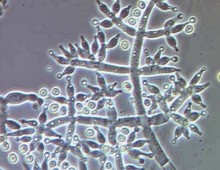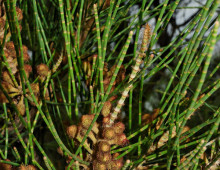Genomic variation is a feature of all natural populations and is vitally important in order to survive changes in their environments. Genetic variation among individuals, to which DNA recombination is an important contributor, is passed from parents to offspring and helps explain that different individuals in the population may harbor a diverse set of traits….
On the hunt for industrial enzymes
Researchers mined DOE JGI’s database of fungal genomes for candidate enzymes for use in a variety of industrial processes. The Science By screening genomes of fungi made publicly available by the DOE Joint Genome Institute researchers identified new versions of enzymes called lipases and sterol esterases. To further study the most promising enzymes, they created…
Salt-tolerant trees and their symbionts
Over 800 million hectares of land throughout the world are salt-affected and a common method for dealing with salt stress problems is to reclaim affected soils with fast-growing salt- tolerant tree species such as Casuarina trees. Fast growing trees from the Casuarinaceae family have been successfully introduced in several tropical and subtropical countries to prevent…
Pilot phase of the Thousand Microbial Genomes project
The Genomic Encyclopedia of Bacteria and Archaea (GEBA) project was launched by the DOE JGI in 2007 as a pilot project with the objective of sequencing 250 bacterial and archaeal genomes. At the time the major project goals were to provide evidence to support the use of the phylogenetic diversity of organisms in the tree…
Carboxysomes and the carbon cycle
Cyanobacteria thrive in a diverse range of habitats. In the oceans they are estimated to fix 40 percent of total carbon globally. Long used as a simple model organism to study plant photosynthesis, they are becoming a platform for production of biofuels and industrially important compounds. All cyanobacteria carry out the key step of carbon…
Reducing methane with rumen microbiome studies
The rumen microbiome is comprised primarily of microbes such as bacteria, methanogenic archaea, fungi, ciliate protozoa and viruses that have evolved to act together to rapidly breakdown of complex plant sugars, and ferment the released sugars to produce short-chain fatty acids. Methane is a potent greenhouse gas (GHG) with a global warming potential 25 times…
Fungal enzymes in the cow rumen
The genes and genomes of microbes in the cow rumen represent a valuable source for new biomass-degrading enzymes that might enable processes to more efficiently convert biomass into biofuels. Fungi make up less than 10 percent of the microbial biomass in the rumen and fungal enzymes appear to have higher specific activities towards plant cell…
Founding a grass transcription factor library
Sequenced at the DOE JGI, Brachypodium distachyon is a small temperate grass that is being used as a model for potential energy crops such as switchgrass, sorghum, and Miscanthus. One of the goals in cultivating bioenergy crops is producing enough biomass to convert and use for biofuel production to meet the nation’s needs. This project…
Focusing on the Agave microbiome
Deserts and drylands currently encompass 40 percent of the Earth’s land surface and a further increase in such areas due to climate change and other processes is expected. There are approximately 200 species of Agave, most native to deserts and drylands in central Mexico and the Southwestern United States. Recently identified as candidate bioenergy feedstocks,…
Macondo wellhead metagenomes
The 2010 Deepwater Horizon oil spill presented researchers with an opportunity to employ a variety of approaches to quantify and model the microbial community composition and activity through successive metabolic petroleum hydrocarbon degradation. The Macondo wellhead oil leak, in the Gulf of Mexico, released a complex mixture of hydrocarbons into the water column that stimulated…


